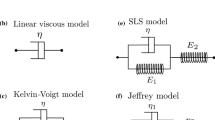Abstract
In this paper mesoscopic (individual based) and macroscopic (population based) models for mesenchymal motion of cells in fibre networks are developed. Mesenchymal motion is a form of cellular movement that occurs in three-dimensions through tissues formed from fibre networks, for example the invasion of tumor metastases through collagen networks. The movement of cells is guided by the directionality of the network and in addition, the network is degraded by proteases. The main results of this paper are derivations of mesoscopic and macroscopic models for mesenchymal motion in a timely varying network tissue. The mesoscopic model is based on a transport equation for correlated random walk and the macroscopic model has the form of a drift-diffusion equation where the mean drift velocity is given by the mean orientation of the tissue and the diffusion tensor is given by the variance-covariance matrix of the tissue orientations. The transport equation as well as the drift-diffusion limit are coupled to a differential equation that describes the tissue changes explicitly, where we distinguish the cases of directed and undirected tissues. As a result the drift velocity and the diffusion tensor are timely varying. We discuss relations to existing models and possible applications.
Similar content being viewed by others
References
Alt W. (1981) Singular perturbation of differential integral equations describing biased random walks. J. Reine Angew. Math. 322, 15–41
Barocas V.H., Tranquillo R.T. (1997) An anisotropic biphasic theory of tissue-equivalent mechanics: The interplay among cell traction, fibrillar network deformation, fibril alignment and cell contact guidance. J. Biomech. Eng. 119, 137–145
Berenschot, G. Vizualization of Diffusion Tensor Imaging. Eindhoven University of Technology, Master Thesis (2003)
Chalub, F.A.C.C., Markovich, P.A., Perthame, B., Schmeiser, C. Kinetic models for chemotaxis and their drift-diffusion limits. Monatsh. Math. 123–141 (2004)
Dallon J.C., Sherratt J.A. (2000) A mathematical model for spatially varying extracellular matrix alignment. SIAM J. Appl. Math. 61, 506–527
Dallon J.C., Sherratt J.A., Maini P.K. (2001) Modelling the effects of transforming growth factor-β on extracellular alignment in dermal wound repair. Wound Rep. Reg. 9, 278–286
Dickinson R. (2000) A generalized transport model for biased cell migration in an anisotropic environment. J. Math. Biol. 40, 97–135
Dickinson R.B. (1997). A model for cell migration by contact guidance. In: Alt W., Deutsch A., Dunn G. (eds). Dynamics of Cell and Tissue Motion. Birkhauser, Basel, pp. 149–158
Dolak Y., Schmeiser C. (2005) Kinetic models for chemotaxis: Hydrodynamic limits and spatio-temporal mechanics. J. Math. Biol. 51, 595–615
Friedl P., Bröcker E.B. (2000) The biology of cell locomotion within three dimensional extracellular matrix. Cell Motility Life Sci. 57, 41–64
Friedl P., Wolf K. (2003) Tumour-cell invasion and migration: diversity and escape mechanisms. Nat. Rev. 3, 362–374
Hillen T. (2004) On L 2-closure of transport equations: the Cattaneo closure. Discrete Cont. Dyn. Syst. B 4(4): 961–982
Hillen T. (2005) On the L 2-closure of transport equations: the general case. Discrete Cont. Dyn. Syst. B 5(2): 299–318
Hillen T., Othmer H.G. (2000) The diffusion limit of transport equations derived from velocity jump processes. SIAM J. Appl. Math. 61(3): 751–775
Hwang H.J., Kang K., Stevens A. (2005) Global solutions of nonlinear transport equations for chemosensitive movement. SIAM J. Math. Anal. 36, 1177–1199
Levermore C.D. (1996) Moment closure hierarchies for kinetic theories. J. Stat. Phys. 83, 1021–1065
Mori S., Crain B.J., Chacko V.P., Zijl P.C.M. (1999) Three-dimensional tracking of axonal projections in the brain by magnetic resonance imaging. Ann. Neurol. 45, 265–269
Othmer H.G., Dunbar S.R., Alt W. (1988) Models of dispersal in biological systems. J. Math. Biol. 26, 263–298
Othmer H.G., Hillen T. (2001) The diffusion limit of transport equations II: Chemotaxis equations. SIAM J. Appl. Math. 62(4): 1122–1250
Robinson J.C. (2001) Infinite-Dimensional Dynamical Systems. Cambridge Texts in Applied Mathematics. Cambridge University Press, Cambridge
Stevens A. (2000) The derivation of chemotaxis-equations as limit dynamics of moderately interacting stochastic many particle systems. SIAM J. Appl. Math. 61(1): 183–212
Tranquillo R.T., Barocas V.H. (1997). A continuum model for the role of fibroblast contact guidance in wound contraction. In: Alt W., Deutsch A., Dunn G. (eds). Dynamics of Cell and Tissue Motion. Birkhauser, Basel, pp. 159–164
Wang, Z., Hillen, T., Li, M. Global existence and travling waves to models for mesenchymal motion in one dimension. (in preparation) 2006
Wolf K., Mazo I., Leung H., Engelke K., von Andria U., Deryngina E.I., Strongin A.Y., Bröcker E.B., Friedl P. (2003) Compensation mechanism in tumor cell migration mesenchymal-amoeboid transition after blocking of pericellular proteolysis. J. Cell Biol. 160, 267–277
Yurchenco P.D., Birk D.E., Mechan R.P. (1994) Extracellular Matrix Assembly. Academic Press, San Diego
Author information
Authors and Affiliations
Corresponding author
Additional information
Dedicated to K.P. Hadeler, a great scientist, teacher, and friend.
Rights and permissions
About this article
Cite this article
Hillen, T. M5 mesoscopic and macroscopic models for mesenchymal motion. J. Math. Biol. 53, 585–616 (2006). https://doi.org/10.1007/s00285-006-0017-y
Received:
Revised:
Published:
Issue Date:
DOI: https://doi.org/10.1007/s00285-006-0017-y




